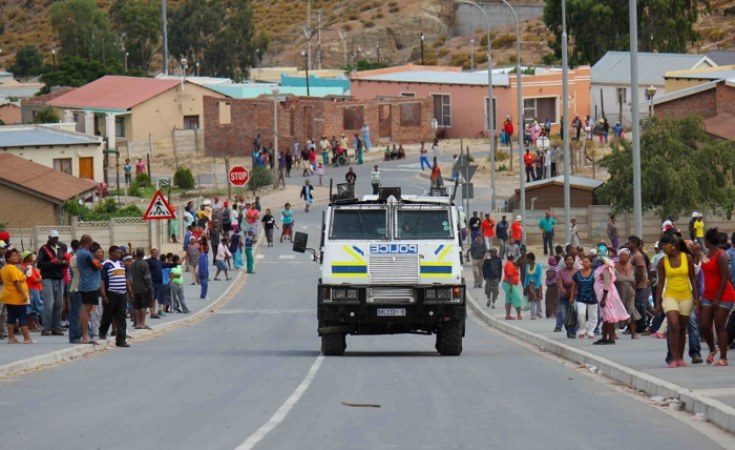South Africa's murder rates are again among the highest globally, but determined, targeted policing can reverse this trend.
There were, on average, 520 murders a week in South Africa during the 2022 calendar year. According to available data, this is one of the highest murder rates in the world.
For years, chronic violence has been part of the South African reality. High levels of fatal violence have become normalised, as if they are an inevitable consequence of other social problems such as unemployment, hunger, poverty and inequality.
These problems seem overwhelming - with no clear vision of what can be done. But South Africans shouldn't accept the continuing high number of killings. Murder can be reduced. By focusing on the places, people and behaviours most regularly associated with lethal violence, the police and their partners can turn this around.
Targeting the risk factors contributing to murder, bringing those individuals responsible to justice, and disrupting the networks that support them, can help decrease this crime.
Murder results from other forms of crime and violence, from domestic abuse to street robbery and organised crime. Multiple other social crises should not distract us from focusing on murder and other forms of crime and violence that it is linked to.
South Africans shouldn't accept the continuing high number of killings
When compared with the size of the population, a small number of people commit the most serious violent crimes, particularly murder. The police make well over a million arrests each year. However, these arrests are not resulting in fewer murders or in reductions of the many other forms of violent crime. That suggests they are targeting the wrong people.
South Africa's decade-long rise in murder is an exception to a global trend. Drawing on data from 202 countries, the United Nations Office on Drugs and Crime (UNODC) noted in its 2019 Global Study on Homicide that the worldwide risk of being murdered had declined consistently for 25 years. But in South Africa, apart from a slight COVID-19-related dip in the 2020/21 financial year, this crime has increased yearly since 2011/12.
In 2022, 27 066 people were murdered in South Africa. This number is 74% higher than what was recorded in the 2011/12 financial year, when 15 554 such killings were recorded.
The 2011/12 rate of 29.5 murders per 100 000 was the lowest per capita rate recorded since the transition to democracy in 1994. (Official crime figures in South Africa are usually reported for the April-to-March financial year. They are not available for all calendar years.)
The fact that only 15% of murder cases are solved suggests entrenched dysfunction in the police
In 2022, South Africa's murder rate was 44.7 per 100 000. It was last this high 20 years ago. According to available international data, only Jamaica had a higher per capita murder rate than South Africa last year.
Murder figures are often regarded as more reliable than other crime data. But comparing murder rates between countries is not an exact science. Governments don't all record and calculate murder similarly. In some states, statistics are not released, and in others, the available data is of poor quality or outdated. Some countries that previously recorded high homicide rates have not reported data for years. The table below shows countries with the highest per capita murder rates in 2022 of those that have available data.
Five countries with the highest per capita rates of murder in 2022
Source: ISS analysis of available homicide data
(click on the chart for the full size image)
To address South Africa's exceptionally high murder rate, the government needs to put the reduction of murder and violence at the top of its agenda. It should be unequivocally clear in word, budgets and activities that decreasing this crime is among its highest priorities.
Not only government but religious organisations, parents, sports teams and others who shape South Africans' values need to convey the message that murder and violence in all its forms must be opposed.
Purposeful steps must be taken to focus on the people, places and behaviours most associated with lethal violence, and to strengthen the investigation and prosecution of murder. Even though many murders are committed by people who know each other, and the perpetrators are often readily identifiable, the South African Police Service currently solves only 15% of murder cases. This suggests entrenched dysfunction.
According to UNODC, 'Nations that fail to establish strong security and justice systems, within a framework of respect for human rights, are more likely to suffer spirals of chronic violence and insecurity.' UNODC also emphasises that interventions must target the people and places most affected. This is the foundational tenet of an evidence-based approach to policing and harm reduction.
South Africa's decade-long rise in murder is an exception to a global trend
In South Africa, 50% of all murders occur in fewer than 170 police station areas, predominantly over weekends, in particular hotspots and within specific social networks. Police in high-violence areas must develop clear, realistic, targeted plans based on an analysis of local violence patterns. Their goal must be to reduce murder while upholding human rights.
The government, and South African society, must clearly prioritise murder reduction. Sufficient resources must be allocated to this goal. In addition, initiatives involving multi-sectoral violence-prevention partnerships will be necessary.
Reducing murder can, in turn, yield many benefits beyond public safety. It will create a social and economic environment that better supports efforts to address unemployment, poverty, inequality and other deeply embedded social problems.
Andrew Faull, Senior Researcher, Justice and Violence Prevention, ISS Pretoria and David Bruce, Independent Researcher and ISS Consultant


